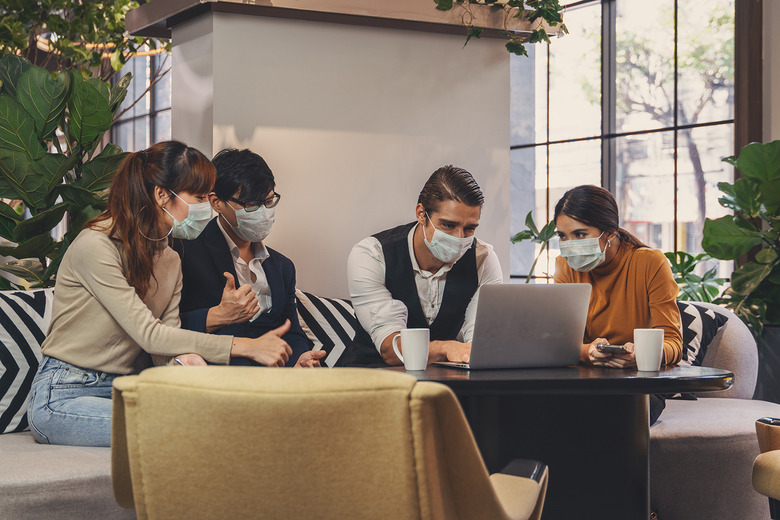Scary Videos Show How Easily Coronavirus Spreads Indoors
- The novel coronavirus is most infectious in poorly ventilated indoor settings where people do not practice social distancing and do not wear masks.
- Using a coronavirus aerosol transmission model, a paper offered illustrations of COVID-19 spreading inside various indoor settings, including a living room, a bar, and a classroom.
- The illustrations show that spending less time in other people's presence, using face masks, and practicing social distancing (even indoors) can significantly reduce the risk of infection.
Aerosol transmission of coronavirus has been one of the hottest topics in recent months. The WHO and CDC have acknowledged that the virus is airborne, but they still say aerosol transmission only happens in certain situations. Droplet transmission is the most important way the novel coronavirus spreads, according to guidelines.
Germany is officially telling people to ventilate their homes and other indoor spaces by opening windows rather than running AC units. Dr. Anthony Fauci also included this tip in a recent interview while offering advice to people on avoiding the spread of the illness in the winter months. He also said people should not be afraid to wear face masks at home if they're not certain whether or not someone is infected.
The consensus seems to be that the more people are in an indoor setting, and the more time they spend inside that space, the higher the risk of getting the virus, even with face masks. A series of incredible animations based on observations about COVID-19 transmission in indoor scenarios shows exactly how easily the virus can spread in a living room, a bar, and a classroom.
Spanish paper El Pais ran various simulations using the Covid Airborne Transmission Estimator developed by scientists from the University of Colorado.
During these simulations, the subjects maintain the recommended safe distance, so the risk of droplets transmission is eliminated. El Pais attempted to measure only the risk of airborne transmission in various indoor settings and scenarios. They looked at the various factors that can increase or decrease the risk of transmission, including the time spent indoors, the use of masks, and ventilation — here's what they found:
Room
Scenario: 6 people in a private home, one of whom is infected, spend time in the same living room.
- 4-hour visit, no face masks, no ventilation: 5 people get infected
- 4-hour visit, universal face masks, no ventilation: 4 people risk infection
- 2-hour visit or shorter, universal face masks, the living room is ventilated: Less than 1 other person risks infection
Bar
Scenario: 15 patrons and 3 staff members in a bar with capacity reduced at 50%, one of whom is infected.
- 4-hour visit, no face masks, no ventilation: 14 people get infected
- 4-hour visit, universal face masks, no ventilation: 8 people get infected
- 2-hour visit, universal face masks, bar is ventilated: 1 person gets infected
Classroom
Scenario: A classroom with 24 students and an infected teacher.
- 2-hour class, no face masks, no ventilation: 12 students get infected irrespective of their seat
- 2-hour class, universal face masks, no ventilation: 5 students get infected irrespective of their seat
- 1-hour class, universal face masks, ventilation with fresh air or AC: The risk drops dramatically
El Pais also reminds us of one of the best-known cases of indoor transmission from early in the pandemic. A single person infected 53 out of 61 people attending the same choir practice in Washington in mid-March after a session that lasted 2.5 hours. Two people ultimately died. Singing in the unventilated space supports the idea of aerosol transmission, especially considering that some of the people who got the virus may have been several feet away.
Scientists who studied the outbreak determined that the risks could have been lowered significantly with airborne transmission measures. Face mask use alone would have reduced the risk to 44% of people getting infected instead of 87%. A shorter rehearsal combined with better ventilation would have reduced the spread dramatically, and only 2 people would have been infected instead of 53.
As with any COVID-19 research, the Spanish paper's simulations might have limitations, and they might not apply to real-life scenarios. Still, the general idea seems to be that combining social distancing with face masks, good ventilation, and reducing the time spent indoors in other people's vicinity can significantly reduce the infection risk.
The full El Pais deserves attention, especially the great illustrations for each of the scenarios above. On top of that, the paper has visuals for the aerosol spread and the number of aerosols that a person can emit while staying silent, talking, and singing.
